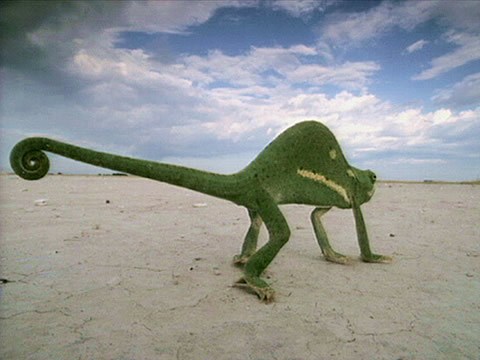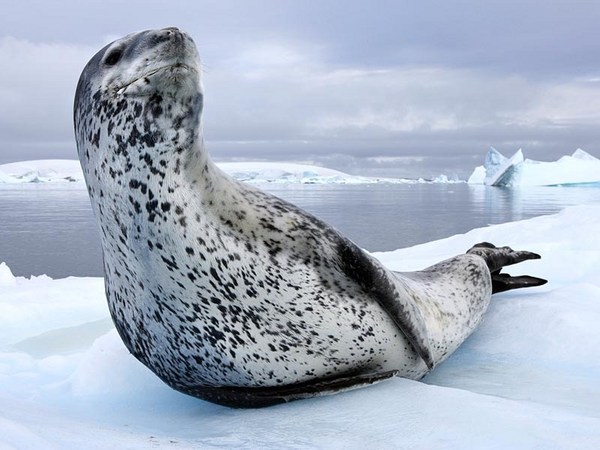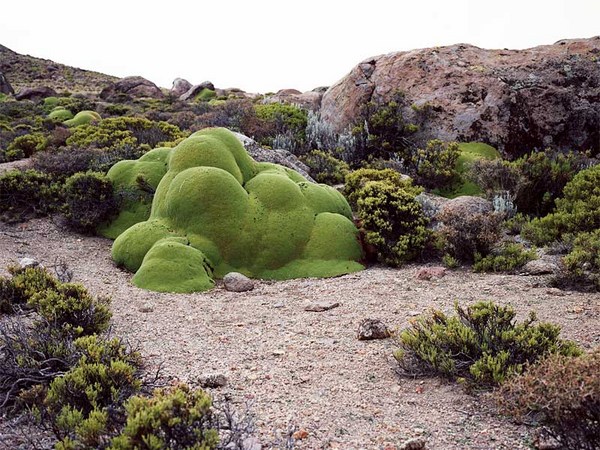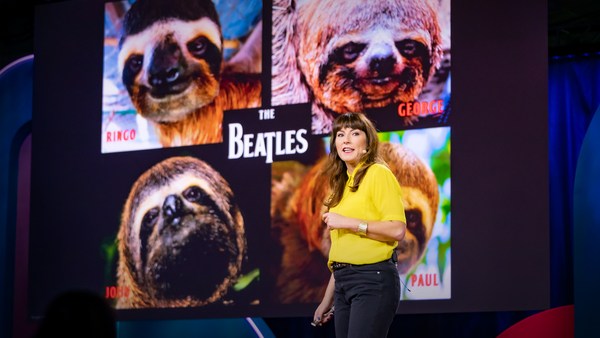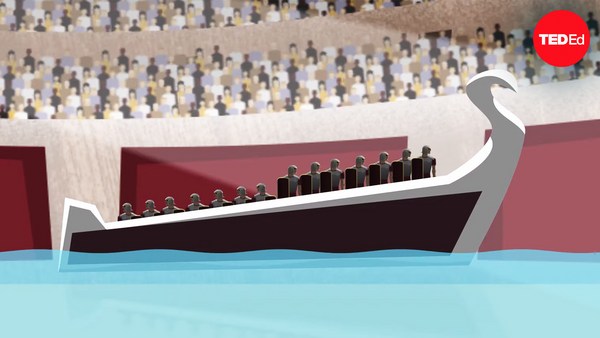So I've had the great privilege of traveling to some incredible places, photographing these distant landscapes and remote cultures all over the world. I love my job.
But people think it's this string of epiphanies and sunrises and rainbows, when in reality, it looks more something like this.
(Laughter)
This is my office.
We can't afford the fanciest places to stay at night, so we tend to sleep a lot outdoors. As long as we can stay dry, that's a bonus. We also can't afford the fanciest restaurants. So we tend to eat whatever's on the local menu. And if you're in the Ecuadorian Páramo, you're going to eat a large rodent called a cuy.
(Laughter)
But what makes our experiences perhaps a little bit different and a little more unique than that of the average person is that we have this gnawing thing in the back of our mind that even in our darkest moments, and those times of despair, we think, "Hey, there might be an image to be made here, there might be a story to be told."
And why is storytelling important? Well, it helps us to connect with our cultural and our natural heritage. And in the Southeast, there's an alarming disconnect between the public and the natural areas that allow us to be here in the first place. We're visual creatures, so we use what we see to teach us what we know.
Now the majority of us aren't going to willingly go way down to a swamp. So how can we still expect those same people to then advocate on behalf of their protection? We can't.
So my job, then, is to use photography as a communication tool, to help bridge the gap between the science and the aesthetics, to get people talking, to get them thinking, and to hopefully, ultimately, get them caring.
I started doing this 15 years ago right here in Gainesville, right here in my backyard. And I fell in love with adventure and discovery, going to explore all these different places that were just minutes from my front doorstep. There are a lot of beautiful places to find. Despite all these years that have passed, I still see the world through the eyes of a child and I try to incorporate that sense of wonderment and that sense of curiosity into my photography as often as I can.
And we're pretty lucky because here in the South, we're still blessed with a relatively blank canvas that we can fill with the most fanciful adventures and incredible experiences. It's just a matter of how far our imagination will take us. See, a lot of people look at this and they say, "Oh yeah, wow, that's a pretty tree." But I don't just see a tree -- I look at this and I see opportunity. I see an entire weekend. Because when I was a kid, these were the types of images that got me off the sofa and dared me to explore, dared me to go find the woods and put my head underwater and see what we have.
And folks, I've been photographing all over the world and I promise you, what we have here in the South, what we have in the Sunshine State, rivals anything else that I've seen. But yet our tourism industry is busy promoting all the wrong things. Before most kids are 12, they'll have been to Disney World more times than they've been in a canoe or camping under a starry sky. And I have nothing against Disney or Mickey; I used to go there, too. But they're missing out on those fundamental connections that create a real sense of pride and ownership for the place that they call home.
And this is compounded by the issue that the landscapes that define our natural heritage and fuel our aquifer for our drinking water have been deemed as scary and dangerous and spooky. When our ancestors first came here, they warned, "Stay out of these areas, they're haunted. They're full of evil spirits and ghosts." I don't know where they came up with that idea. But it's actually led to a very real disconnect, a very real negative mentality that has kept the public disinterested, silent, and ultimately, our environment at risk. We're a state that's surrounded and defined by water, and yet for centuries, swamps and wetlands have been regarded as these obstacles to overcome. And so we've treated them as these second-class ecosystems, because they have very little monetary value and of course, they're known to harbor alligators and snakes -- which, I'll admit, these aren't the most cuddly of ambassadors.
(Laughter)
So it became assumed, then, that the only good swamp was a drained swamp. And in fact, draining a swamp to make way for agriculture and development was considered the very essence of conservation not too long ago.
But now we're backpedaling, because the more we come to learn about these sodden landscapes, the more secrets we're starting to unlock about interspecies relationships and the connectivity of habitats, watersheds and flyways. Take this bird, for example: this is the prothonotary warbler. I love this bird because it's a swamp bird, through and through, a swamp bird. They nest and they mate and they breed in these old-growth swamps in these flooded forests. And so after the spring, after they raise their young, they then fly thousand of miles over the Gulf of Mexico into Central and South America. And then after the winter, the spring rolls around and they come back. They fly thousands of miles over the Gulf of Mexico. And where do they go? Where do they land? Right back in the same tree. That's nuts. This is a bird the size of a tennis ball -- I mean, that's crazy! I used a GPS to get here today, and this is my hometown.
(Laughter)
It's crazy. So what happens, then, when this bird flies over the Gulf of Mexico into Central America for the winter and then the spring rolls around and it flies back, and it comes back to this: a freshly sodded golf course?
This is a narrative that's all too commonly unraveling here in this state. And this is a natural process that's occurred for thousands of years and we're just now learning about it. So you can imagine all else we have to learn about these landscapes if we just preserve them first. Now despite all this rich life that abounds in these swamps, they still have a bad name.
Many people feel uncomfortable with the idea of wading into Florida's blackwater. I can understand that. But what I loved about growing up in the Sunshine State is that for so many of us, we live with this latent but very palpable fear that when we put our toes into the water, there might be something much more ancient and much more adapted than we are. Knowing that you're not top dog is a welcomed discomfort, I think. How often in this modern and urban and digital age do you actually get the chance to feel vulnerable, or consider that the world may not have been made for just us?
So for the last decade, I began seeking out these areas where the concrete yields to forest and the pines turn to cypress, and I viewed all these mosquitoes and reptiles, all these discomforts, as affirmations that I'd found true wilderness, and I embrace them wholly. Now as a conservation photographer obsessed with blackwater, it's only fitting that I'd eventually end up in the most famous swamp of all: the Everglades.
Growing up here in North Central Florida, it always had these enchanted names, places like Loxahatchee and Fakahatchee, Corkscrew, Big Cypress. I started what turned into a five-year project to hopefully reintroduce the Everglades in a new light, in a more inspired light. But I knew this would be a tall order, because here you have an area that's roughly a third the size the state of Florida, it's huge. And when I say Everglades, most people are like, "Oh, yeah, the national park." But the Everglades is not just a park; it's an entire watershed, starting with the Kissimmee chain of lakes in the north, and then as the rains would fall in the summer, these downpours would flow into Lake Okeechobee, and Lake Okeechobee would fill up and it would overflow its banks and spill southward, ever slowly, with the topography, and get into the river of grass, the Sawgrass Prairies, before meting into the cypress slews, until going further south into the mangrove swamps, and then finally -- finally -- reaching Florida Bay, the emerald gem of the Everglades, the great estuary, the 850 square-mile estuary.
So sure, the national park is the southern end of this system, but all the things that make it unique are these inputs that come in, the fresh water that starts 100 miles north. So no manner of these political or invisible boundaries protect the park from polluted water or insufficient water. And unfortunately, that's precisely what we've done. Over the last 60 years, we have drained, we have dammed, we have dredged the Everglades to where now only one third of the water that used to reach the bay now reaches the bay today. So this story is not all sunshine and rainbows, unfortunately. For better or for worse, the story of the Everglades is intrinsically tied to the peaks and the valleys of mankind's relationship with the natural world.
But I'll show you these beautiful pictures, because it gets you on board. And while I have your attention, I can tell you the real story. It's that we're taking this, and we're trading it for this, at an alarming rate. And what's lost on so many people is the sheer scale of which we're discussing. Because the Everglades is not just responsible for the drinking water for 7 million Floridians; today it also provides the agricultural fields for the year-round tomatoes and oranges for over 300 million Americans. And it's that same seasonal pulse of water in the summer that built the river of grass 6,000 years ago. Ironically, today, it's also responsible for the over half a million acres of the endless river of sugarcane. These are the same fields that are responsible for dumping exceedingly high levels of fertilizers into the watershed, forever changing the system.
But in order for you to not just understand how this system works, but to also get personally connected to it, I decided to break the story down into several different narratives. And I wanted that story to start in Lake Okeechobee, the beating heart of the Everglade system. And to do that, I picked an ambassador, an iconic species. This is the Everglade snail kite. It's a great bird, and they used to nest in the thousands, thousands in the northern Everglades. And then they've gone down to about 400 nesting pairs today. And why is that? Well, it's because they eat one source of food, an apple snail, about the size of a ping-pong ball, an aquatic gastropod.
So as we started damming up the Everglades, as we started diking Lake Okeechobee and draining the wetlands, we lost the habitat for the snail. And thus, the population of the kites declined. And so, I wanted a photo that would not only communicate this relationship between wetland, snail and bird, but I also wanted a photo that would communicate how incredible this relationship was, and how very important it is that they've come to depend on each other, this healthy wetland and this bird. And to do that, I brainstormed this idea. I started sketching out these plans to make a photo, and I sent it to the wildlife biologist down in Okeechobee -- this is an endangered bird, so it takes special permission to do. So I built this submerged platform that would hold snails just right under the water. And I spent months planning this crazy idea. And I took this platform down to Lake Okeechobee and I spent over a week in the water, wading waist-deep, 9-hour shifts from dawn until dusk, to get one image that I thought might communicate this. And here's the day that it finally worked:
[Video: (Mac Stone narrating) After setting up the platform, I look off and I see a kite coming over the cattails. And I see him scanning and searching. And he gets right over the trap, and I see that he's seen it. And he beelines, he goes straight for the trap. And in that moment, all those months of planning, waiting, all the sunburn, mosquito bites -- suddenly, they're all worth it. (Mac Stone in film) Oh my gosh, I can't believe it!]
You can believe how excited I was when that happened. But what the idea was, is that for someone who's never seen this bird and has no reason to care about it, these photos, these new perspectives, will help shed a little new light on just one species that makes this watershed so incredible, so valuable, so important. Now, I know I can't come here to Gainesville and talk to you about animals in the Everglades without talking about gators. I love gators, I grew up loving gators. My parents always said I had an unhealthy relationship with gators. But what I like about them is, they're like the freshwater equivalent of sharks. They're feared, they're hated, and they are tragically misunderstood. Because these are a unique species, they're not just apex predators. In the Everglades, they are the very architects of the Everglades, because as the water drops down in the winter during the dry season, they start excavating these holes called gator holes. And they do this because as the water drops down, they'll be able to stay wet and they'll be able to forage. And now this isn't just affecting them, other animals also depend on this relationship, so they become a keystone species as well. So how do you make an apex predator, an ancient reptile, at once look like it dominates the system, but at the same time, look vulnerable? Well, you wade into a pit of about 120 of them, then you hope that you've made the right decision.
(Laughter)
I still have all my fingers, it's cool.
But I understand, I know I'm not going to rally you guys, I'm not going to rally the troops to "Save the Everglades for the gators!" It won't happen because they're so ubiquitous, we see them now, they're one of the great conservation success stories of the US. But there is one species in the Everglades that no matter who you are, you can't help but love, too, and that's the roseate spoonbill. These birds are great, but they've had a really tough time in the Everglades, because they started out with thousands of nesting pairs in Florida Bay, and at the turn of the 20th century, they got down to two -- two nesting pairs. And why? That's because women thought they looked better on their hats then they did flying in the sky. Then we banned the plume trade, and their numbers started rebounding. And as their numbers started rebounding, scientists began to pay attention, they started studying these birds.
And what they found out is that these birds' behavior is intrinsically tied to the annual draw-down cycle of water in the Everglades, the thing that defines the Everglades watershed. What they found out is that these birds started nesting in the winter as the water drew down, because they're tactile feeders, so they have to touch whatever they eat. And so they wait for these concentrated pools of fish to be able to feed enough to feed their young. So these birds became the very icon of the Everglades -- an indicator species of the overall health of the system. And just as their numbers were rebounding in the mid-20th century -- shooting up to 900, 1,000, 1,100, 1,200 -- just as that started happening, we started draining the southern Everglades. And we stopped two-thirds of that water from moving south. And it had drastic consequences. And just as those numbers started reaching their peak, unfortunately, today, the real spoonbill story, the real photo of what it looks like is more something like this. And we're down to less than 70 nesting pairs in Florida Bay today, because we've disrupted the system so much. So all these different organizations are shouting, they're screaming, "The Everglades is fragile! It's fragile!" It is not. It is resilient. Because despite all we've taken, despite all we've done and we've drained and we've dammed and we've dredged it, pieces of it are still here, waiting to be put back together.
And this is what I've loved about South Florida, that in one place, you have this unstoppable force of mankind meeting the immovable object of tropical nature. And it's at this new frontier that we are forced with a new appraisal. What is wilderness worth? What is the value of biodiversity, or our drinking water? And fortunately, after decades of debate, we're finally starting to act on those questions. We're slowly undertaking these projects to bring more freshwater back to the bay. But it's up to us as citizens, as residents, as stewards to hold our elected officials to their promises.
What can you do to help? It's so easy. Just get outside, get out there. Take your friends out, take your kids out, take your family out. Hire a fishing guide. Show the state that protecting wilderness not only makes ecological sense, but economic sense as well. It's a lot of fun, just do it -- put your feet in the water. The swamp will change you, I promise.
Over the years, we've been so generous with these other landscapes around the country, cloaking them with this American pride, places that we now consider to define us: Grand Canyon, Yosemite, Yellowstone. And we use these parks and these natural areas as beacons and as cultural compasses. And sadly, the Everglades is very commonly left out of that conversation. But I believe it's every bit as iconic and emblematic of who we are as a country as any of these other wildernesses. It's just a different kind of wild.
But I'm encouraged, because maybe we're finally starting to come around, because what was once deemed this swampy wasteland, today is a World Heritage site. It's a wetland of international importance. And we've come a long way in the last 60 years. And as the world's largest and most ambitious wetland restoration project, the international spotlight is on us in the Sunshine State. Because if we can heal this system, it's going to become an icon for wetland restoration all over the world. But it's up to us to decide which legacy we want to attach our flag to.
They say that the Everglades is our greatest test. If we pass it, we get to keep the planet. I love that quote, because it's a challenge, it's a prod. Can we do it? Will we do it? We have to, we must. But the Everglades is not just a test. It's also a gift, and ultimately, our responsibility.
Thank you.
(Applause)
